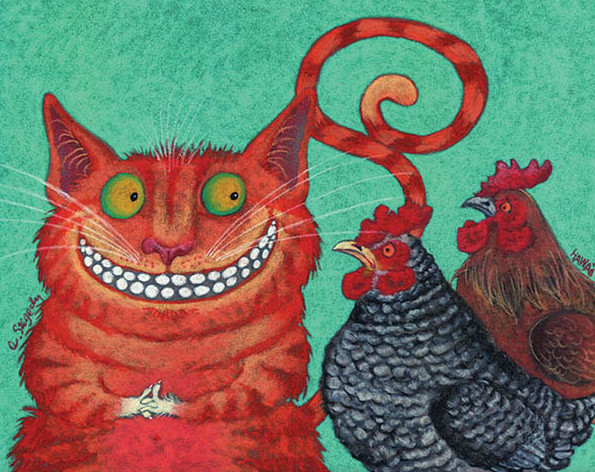
Whimsical Art and Storyteller Esther Szegedy
 By Stephanie Bolton
By Stephanie Bolton
Wide, bright eyes, and dancing vivid colors… am I describing her artwork or Esther, herself? Upon meeting for lunch at the Holuakoa Gardens and Cafe one Saturday afternoon, I had the pleasure of learning some of the colorful details of the life of this compelling local artist.
Usually working in watercolor pencils and wax water based pastels, Esther Szegedy’s artwork has rich, lively colors that play wildly on the page. She paints animated animals, extravagant exotic flowers, active island children, and Polynesian ladies. When she arrived on Hawai‘i Island 20 years ago, she was doing educational publishing, which she says can sometimes be painfully boring. “I’d get an assignment and sit for five minutes and just cry. Then figure out how to make it interesting. Sometimes they’d make me do something I nearly felt ashamed of because I felt like I was helping to reinforce stereotypes. The publishers hired me to do different ethnicities, and then they wanted everyone to look as Caucasian as possible. This really drained the creative process of its innate joy. I was often upset by this, and at the same time this is partly what inspired me to write my own stories as well as illustrating them.’’
“If I’d draw children running and jumping and there was a belly button showing, they’d have me erase the belly button. I got so mad that now when I do my own work everything has a belly button. Dogs, birds, EVERYTHING! It is my way of rebelling. I make sure everything has a belly button … except for snakes, only because I can’t figure out where their belly button should go!” She laughs.
Currently Esther is working on a book about a surfer dog. “I didn’t want to make him any specific breed so that more people could relate to him. It’s based on when I used to swim with the dolphins almost every day. I decided to make the main character a dog instead of a human because I thought it would be more fun.
In the story the dog ends up on a boogie board out in the ocean and encounters everything from dolphins, ulua, swordfish, rays, and sharks—just like I did, and I thought it would be more fun with a dog having these experiences.”
Esther Szedgedy moved to Hawai‘i Island from New Mexico. She had wanted to live in Hawai‘i since she was five years old: she was convinced that God had made a terrible mistake placing her in Toronto. Drawn to fishing, swimming, and sunshine, she hated the winter and lived for the summer; she had a canoe and a rowboat, and drove her family’s motor boats every chance she got.
Esther was born in Toronto, Canada to Hungarian parents and began her first days of school not knowing a word of English. “My parents moved from Europe to Canada after being in a refugee camp in Great Britain, so they spoke British English with a very heavy Hungarian accent and the Canadians couldn’t understand them! So they didn’t want to teach me English because they were afraid I would pick up their accent.”
“Canada was not a racially mixed place back then, as it is now,” she explained. They moved into an Irish neighborhood and Esther found herself to be in the only family on the street with dark eyes and dark hair.
Needless to say, she knew what it was like as a child growing up feeling very different and alone; something that actually fuels wonderful inspiration for her own stories for children.
At eighteen years old she went to an art school with hopes of becoming a book illustrator. Her first professor had these ‘encouraging’ words to impart, “You have no talent whatsoever; go home, become a housewife, and forget about art.”
And after completing 33 etchings she showed them to her etching professor who said, “Destroy these and forget they ever happened.” Esther began to wonder what she was doing there. Instead of taking his advice, she left school, and two years later opened the first of three stores that sold mostly her own work for the next 13 years—everything from books to CD covers.
Even though the business was successful, she began to feel caged between those walls and longed for more freedom. So she went back to school in Cambridge, Massachusetts, to become a therapist. In her therapy practice, art once again made its way back into her life as a useful tool in helping her to connect with patients.
She interned in Boston, working in locked wards with schizophrenic patients, often with convicted criminals. She loved the work, and constantly took issue with the Harvard-trained psychiatrists’ diagnoses. Because she had patients’ artwork to prove her differing observations, eventually the psychiatrists conceded to her points. She was very popular with the patients and very unpopular with the psychiatrists.
“After this, I moved to Santa Fe, New Mexico and many of my patients were Navajo or Hopi Indians. They cared less about sitting and talking, yet loved to work with their hands. Giving them art projects helped them to heal themselves.” Illustrating children’s books was still the longing of her heart and she eventually got agents and entered the world of educational publishing before finally moving to where the five-year-old Esther knew she truly belonged—Hawai‘i.
When I asked Esther if she had any children of her own she said, “All my life I have worked for them and I began to wonder, how can I be a children’s book illustrator if I don’t have children?” This question led her to investigate the lives of some of her favorite children’s book illustrators. Maurice Sendak who wrote and illustrated Where the Wild Things Are never had children. Beatrix Potter who wrote and illustrated The Tale of Peter Rabbit never had children. Dr. Seuss never had children, and when this was commented on by an interviewer, his answer was: “Let me put it this way: you make ‘em; I entertain ‘em.” So it became clear to her that having children was certainly not mandatory for writing and illustrating great children’s books.
“In all seriousness, I feel there is no way you could be a full-time illustrator and be a full-time mother, they both require so much focus. And the reason that Dr. Seuss could be a therapist and an illustrator is because he had a wife to answer the phone and take care of absolutely everything distracting. All he had to do was sit in his studio and draw. When I read his biography, I said I needed a wife, and then I got one.”
This remark confused me, “You have a wife?” I asked. “Yes,” Esther said with a sly smile inching across her face, “It’s my husband. He does everything better than me: cooking, washing the car, doing my framing…”
He was living in France at the time, and was visiting an artist friend on Hawai‘i Island who wanted me to meet him. “But I didn’t want to date a guy from Paris! Even Volcano is too far of a drive, Paris is definitely too far to go.”
However, she agreed to meet him for a coffee at Borders. When he stepped out of his car she saw his face and thought, “That’s it. That’s the man I’m gonna marry.” And she thought she had lost her mind. “I was perfectly happy not having a boyfriend, living in my little cottage in Kealakekua, swimming with the dolphins every day, and now I wanted to marry a man I’d only known for five minutes … what?!”
Now Esther is working on writing and illustrating her own children’s books, and her husband is taking an interest in book binding. He helped her fashion some prototypes of the works in progress. When she took them to schools, the kindergarteners would rush up to her after she finished the story and want her autograph. “They didn’t realize the books were handmade and that I wasn’t a famous writer. I’m still looking for someone to publish these books.”
Reading in the schools was great experience for Esther to see if her stories were working. She could tell the children were engaged because they didn’t run off to do something else after a few minutes, instead they would sit and listen. A teacher remarked, “I’ve never seen them sit still this long for anybody.” Esther went to the schools a lot when she lived on the west side of the island. If the children were older, she told them how to fashion their own books.
I asked Esther how she ended up getting her work into fine art galleries and she told me, “It was on a dare!
Somebody from Holualoa said that The Fairmont Orchid Hotel was showing artists’ work every other Friday.
They told me I should try this—everyone else was doing it. So I finished some paintings down at the Old Airport on the picnic tables because my little cottage in Kealakekua was too dark to do artwork in. When I brought the paintings to the first gallery and unwrapped them, the manager picked one up and went into the gallery. He took something off the wall and started hanging my artwork on the wall. I asked him what he was doing and he said that he liked my painting better than what had been there and I was one of the first local artists that they represented.”
Esther’s artwork continues to sell well in local galleries, particularly her depictions of cats and dogs. “I don’t have a dog personally,” says Esther. “I have a cat and I had a duck. I did a portrait of my duck that was bought by the State Foundation in Honolulu and they tell me (which may or may not be true), that it’s hanging in the Mayor’s office in Honolulu. I laughed! I do all this Hawaiiana and instead they buy my duck in a superman cape?” ❖
Contact the artist: Esther-Szegedy.com
Contact writer Stephanie Bolton: mauna.lea.studios@gmail.com


